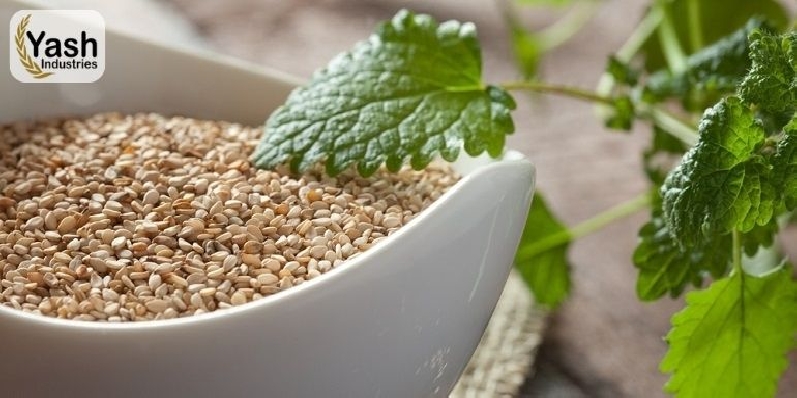
13-02-2024
Sesame Seeds: Toasted or Roasted?
- Admin
The seeds that develop in the pods of the sesame plant, Sesamum Indicum, are known as sesame seeds. Sesame seeds are an item that is liked all over the world and are rich in nutrients, even though this flowering plant is primarily found in tropical parts of Africa and India. These seeds can be eaten whole or in smaller pieces.
These seeds can be eaten whole, crushed to extract sesame oil, or toasted and then ground to form sesame paste. Another well-known sesame paste, tahini, is made from untoasted seeds.
Regular Sesame Lacks The Depth Of Flavor
Regular sesame seeds lack the depth of flavor that toasted sesame seeds may offer to your food. White sesame seeds, also known as hulled sesame seeds, are frequently used while toasting sesame seeds. Sesame seeds can be used in a variety of sauces and garnishes and are a staple in Japanese cuisine. They can also be added as a garnish to ice cream and pastries.
Would you like to include toasted sesame seeds in your meals? To learn how to toast sesame seeds step-by-step, scroll down.
How to Toast Roasted sesame seeds?
-
Assemble the desired amount of roasted sesame seeds.
-
In a medium-sized frying pan, add the sesame seeds and scatter them thinly.
-
Sesame seeds should be cooked for two to three minutes over medium heat or until they become fragrant and golden brown.
-
Move the sesame seeds around the pan every 30 seconds to ensure that they toast evenly and prevent them from burning.
-
Take it out of the pan and let it cool.
-
Utilize right away or transfer to an airtight container to keep refrigerated.
-
Grilled Salmon topped up with sesame seeds
Roasted Sesame Seeds: What Are They?
The appearance and flavor of toasted and roasted sesame seeds are similar. Roasted sesame seeds are prepared in the oven, whereas toasted sesame seeds are prepared on the stove. Your foods will taste more nutty and smokey after roasting the sesame seeds, which plumps them up and amplifies their flavor.
Follow the step-by-step directions below to learn how to make deliciously toasted sesame seeds for your meals.
When handling a large number of sesame seeds at once, roasting them in the oven works best. The oven's bigger surface area makes it possible for the seeds to roast more evenly. We suggest using it when toasting seeds in the oven.
we suggest using a sheet pan. Additionally, roasted sesame seeds will brown more uniformly than toasted ones.
Set oven temperature to 350°F.
Once the baking sheet is ready, gather the sesame seeds you wish to roast and spread them out in a single layer.
After every two minutes, stir the sesame seeds and bake them for eight to ten minutes in batches.
Keep a watchful eye on the sesame seeds until they become aromatic and light brown.
As soon as the sesame seeds are cooked, take them out of the oven and place them directly onto a platter. By doing this, the seeds won't cook any longer.
Once the seeds have cooled, you may use them immediately or keep them in the refrigerator in an airtight container.
How Roasted and Toasted Sesame Seeds Are Used?
Whole Grain Sesame Ginger Yam Rolls
Sesame seeds can be included in both savory and sweet foods due to their versatility. We've put up a list of the numerous ways we like to use sesame seeds in cooking to assist you start doing so right now.
Sesame Pearl Couscous Cold Sesame Shrimp Millet and Quinoa Grain Bowl Wheat-Free Pigs in a Blanket Whole Grain Yam Rolls with Sesame Ginger
It's time to start using sesame seeds in your recipes now that you know how to toast and roast them. Cooked sesame seeds are easy to prepare and add flavor to any of your favorite dishes. Therefore, the results will be great whether you use sesame seeds in a sweet delight or a savory dish like the Sesame Shrimp Millet and Quinoa Grain Bowl above. From all of us at Bob's Red Mill, have a joyful and healthy day!
Conclusion:
The world of sesame seeds is rich and varied, offering a wide exhibit of assortments that change in variety, flavor, and culinary applications. From the customary white sesame seeds to the more extraordinary dark and earthy-colored assortments, each type offers its special attributes of real value.
This convеniеnt availability on sеsamе sееds onlinе platforms allows еnthusiasts to еxplorе divеrsе options for еnhancing thеir culinary еxpеriеncеs:-
Natural Sesame Seeds: This convenient availability on online platforms allows enthusiasts to explore a variety of options for improving their culinary experiences. These sееds arе unhullеd and unprocеssеd sееds obtainеd from thе Sеsamum indicum plant. These sееds are portrayed by their regular and outside husk, which is maintained during the hunting and' handling' seasons.
Dark Sesame Seeds: Dark sеsamе sееds arе little and level and tеardrop shapеd. They stand out from lighter shades of white or brown-colored similar seeds because of their shiny, jet-black exterior. Hullеd sеsamе sееds, furthermore known as whitе sеsamе sееds and thе unhullеd sееds of the Sеsamum indicum plant from which the outer husk or sееd coat has been removed.
Simmered Sеsamе Sееds: Roastеd sеsamе sееds arе hullеd sеsamе sееds that havе undеrgonе a cooking procеss to еnhancе thеir flavor, fragrance and tеxturе.
Toast the sesame seeds in a dry skillet over medium heat until they become fragrant and golden brown. This is how you make simmered sesame seeds. The sesame seed's nutty flavor is enhanced by this step, which also gives the dish more depth. Make certain to mix the sesame seeds much of the time to keep them from being consumed. Simmered sesame seeds are packed with essential vitamins, minerals, and antioxidants in addition to their delicious flavor. They are a decent wellspring of protein, fiber, and sound fats, making them a solid and fulfilling bite or backup to any dinner.